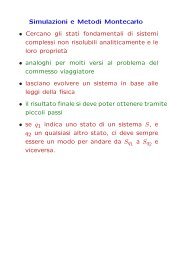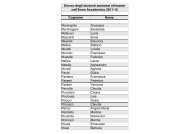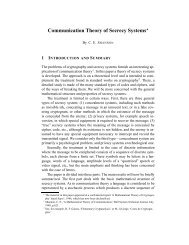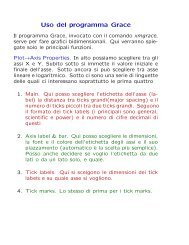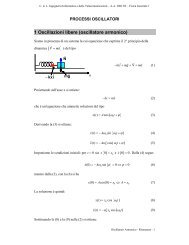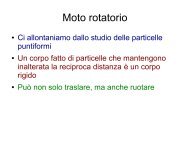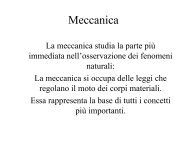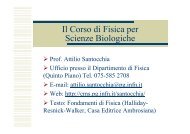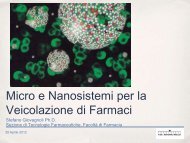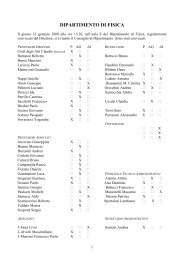PDF (119 KB) - Fisica
PDF (119 KB) - Fisica
PDF (119 KB) - Fisica
You also want an ePaper? Increase the reach of your titles
YUMPU automatically turns print PDFs into web optimized ePapers that Google loves.
with s 0 approximately independent of both T and a, and<br />
B =[C/TSc(0)] only dependent on temperature, on the<br />
assumption that the variation of C with a is negligible –<br />
i.e., the relaxation time data vs a should lie on a Vogel–Fulcher-like<br />
curve that extrapolates to infinity at a = a0. Contrary<br />
to what is done by Johari [1], the consequences of Eq.<br />
(1) should be analyzed within the physical conditions that<br />
allow this relation to hold valid. In particular, a tendency<br />
of S c to zero (i.e., of s to diverge) at a finite a 0, as extrapolated<br />
from data at a < a0, does not imply a true vanishing<br />
of Sc (i.e., a divergence of s) ata0. The reaction, in fact, is<br />
not prevented from departing from Eq. (1) and from proceeding<br />
to an extent greater than a0, if the conditions for<br />
Eq. (1) are progressively removed. As a matter of fact<br />
any polymerization can be brought to its full extent by progressively<br />
increasing the reaction temperature, and this is<br />
normally used to estimate the total heat of reaction via calorimetry.<br />
It is also possible when the reaction temperature<br />
is high that the system remains fluid at even full reaction, as<br />
recognized in [1].<br />
While data at a close to or higher than a0 are of no use<br />
for testing a correlation between Sc and s through a test of<br />
Eq. (2), a large amount of relaxation time data in the expected<br />
range of validity of Eq. (1) have been analyzed,<br />
from which an excellent agreement with Eq. (2) has turned<br />
out with the parameter a0 predicted on a molecular basis<br />
[2,6,7]. The observation that this relationship applies to a<br />
wide range of systems investigated, in different conditions,<br />
using different experimental methods, by numerous authors<br />
is hard to be seen as coincidental. Instead, it strongly suggests<br />
that the essence of the relaxational slowdown on polymerization<br />
can be traced back to a bond-controlled<br />
reduction in the number of configurations available to<br />
the system.<br />
Further experiments by our group – in which the characteristics<br />
of the systems investigated and the experimental<br />
conditions have been chosen to meet the requirements for<br />
Eq. (2), mentioned above – have strengthened the basis<br />
for Eq. (1) in combination with the Adam–Gibbs relation,<br />
particularly persuasive being the results for a number of<br />
epoxy–amine mixtures composed of two reagents (DGE-<br />
BA–DETA) in different molar ratios [8]. Because a0 may<br />
be controlled by varying the molar ratio of reagents in<br />
the initial mixture (solid line in Fig. 1), according to Eq.<br />
(2) the extent of reaction at which the relaxation time<br />
behavior appears to diverge would also be varied in the<br />
same way. We have found, for each reaction carried out<br />
isothermally, that Eq. (2) represents the relaxation time<br />
data well, in a wide relaxation range (at least five decades<br />
for s >10 4 s), where xn(a) is few units [8]. The derived values<br />
for the fitting parameter a0 are reported in Fig. 1. Indeed,<br />
Fig. 1 reveals that a0 not only changes with the<br />
mixture composition but (within the experimental error)<br />
actually follows the expected variation with the molar ratio<br />
(N a/N e) of the reacting molecules, in a wide N a/N e range.<br />
Moreover, the same a 0 is obtained by reacting a given mixture<br />
at different temperatures [9], despite the time-depen-<br />
S. Corezzi et al. / Chemical Physics 323 (2006) 622–624 623<br />
α 0<br />
1.0<br />
0.9<br />
0.8<br />
0.7<br />
0.6<br />
10:3<br />
5:2<br />
5:2.8<br />
10:9<br />
0.2 0.3 0.4 0.5 0.6<br />
Na /Ne 0.7 0.8 0.9 1.0<br />
Fig. 1. Variation of the parameter a 0 with the molar ratio N a/N e between<br />
the amino and the epoxy monomer constituents of the system DGEBA–<br />
DETA Ne:Na. The experimental points for different compositions are<br />
labelled by their Ne:Na values. Open symbols are used to distinguish a<br />
different reaction temperature. The solid line is a 0 =[1+(N a/N e)]/2,<br />
calculated from the functionality and the molar ratio of the reacting<br />
molecules.<br />
dent evolution of the reaction is greatly affected. This is<br />
shown in Fig. 1 by closed and open symbols. In the same<br />
figure, isoabscissa closed-points refer to reactions repeated<br />
at the same temperature to check reproducibility.<br />
(2) A number of other observations reported by Johari<br />
deserve our comment. It is asserted in [1] that a connection<br />
between the relaxation time and a by using the Adam–<br />
Gibbs equation can be made only by allowing Dl, and<br />
therefore, the quantity B / Dl to change with a, being<br />
Dl a free-energy barrier per cooperative unit. We notice<br />
that this is the opposite of what the same author maintained<br />
in previous studies of polymerization [10–12]. Apart<br />
from this contradiction, we observe that as long as multimers<br />
behave effectively like cooperative units a variation<br />
of Dl with a seems not to be required by the theory [3].<br />
On the other hand, if one would be forcing Eq. (2) with<br />
wrong but constant values of B, to fit the experimental data<br />
for polymerizations with Dl strongly varying with a, the<br />
values a0 which describe the data could scarcely correspond<br />
to the values of a physical quantity, i.e., the molecular<br />
parameter a0 calculated from the functionality of the reagents.<br />
This suggests that a sensible variation of Dl with<br />
a is not required either by the experimental data. A minor<br />
variation can, of course, account for details.<br />
Moreover, it is asserted in [1] that s 0 in Eq. (2) should<br />
necessarily correspond to the time scale of phonons, i.e.,<br />
10 13 –10 14 s. There is no question that in simple glassforming<br />
liquids analyses using the Adam–Gibbs approach<br />
usually do give pre-exponents not too far from the phonon<br />
time scale, though the values obtained notoriously span<br />
several decades (e.g., from 10 10.5 to 10 17.3 sin[14]). We<br />
remark that for it to be a general expectation the pre-exponent<br />
s 0 should represent the true value of s in the limit<br />
T !1, and different spectroscopic techniques (such as<br />
dielectric and photon-correlation spectroscopy) should<br />
measure the same s. Neither of these is the case. It is<br />
4:3



